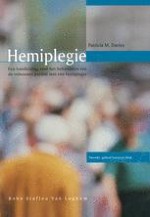Gepubliceerd in:
2001 | OriginalPaper | Hoofdstuk
6. Normaliseren van de houdingstonus en de patiënt leren selectief en zonder overmatige inspanning te bewegen
Abstract
Het normaliseren van de spiertonus en de patiënt leren zonder inspanning in een normaal patroon te bewegen is misschien wel de belangrijkste en moeilijkste taak van de therapeut. Wanneer de tonus te laag is, zal de patiënt niet in staat zijn zichzelf of delen van zijn lichaam tegen de zwaartekracht in omhoog te houden. Als de tonus te hoog is en spasticiteit een probleem vormt, zal de patiënt alleen met grote inspanning en in totaalpatronen tegen de weerstand van de hypertone spieren in kunnen bewegen. Een van deze twee problemen kan overheersen, maar in de meeste gevallen betreft het een combinatie van beide, of er is sprake van een spiertonus die fluctueert tussen te hoog en te laag. Hoe de patiënt overdag beweegt en in welke houdingen hij zich bevindt, heeft een aanzienlijke invloed op de tonus (zie hoofdstuk 5 en 10). Wanneer de patiënt bij aanwezigheid van hypertonic of hypotonic probeert zonder hulp te bewegen, zal dat zeker leiden tot verdere tonusafwijkingen.
